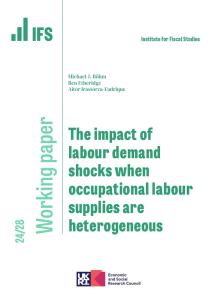Free part-time childcare places for all 3- and 4-year-olds in England were introduced in the early 2000s. The government is now planning to extend this offer from 15 to 30 hours per week (still for 38 weeks of the year) for children in working families from September 2017. One of the aims of the policy is to enable parents to work more – but is it likely to achieve this aim? This briefing note draws on the findings of a new IFS working paper, ‘Free childcare and parents’ labour supply: is more better?’, by Mike Brewer, Sarah Cattan, Claire Crawford and Birgitta Rabe, to try to answer this question.
In this new work, the researchers compared what happened to the labour market outcomes of mothers and fathers as their children moved from being entitled to a free part-time nursery place (offering 15 hours of free childcare per week) to a full-time place at primary school (which effectively offers parents 30–35 hours of free childcare per week).
The research found no evidence that the work patterns of mothers with younger children, or those of fathers, were affected. There was evidence of an effect for mothers whose youngest child became eligible for free full-time care, but this was still relatively small: at the end of the first year of entitlement to free full-time care, mothers whose youngest child was eligible were found to be 5.7 percentage points more likely to be in the labour force and 3.5 percentage points more likely to be in work than mothers whose youngest child was at the end of their first year of part-time entitlement. This was equivalent to around 12,000 more mothers in work each year.
Should we infer from these results that the planned increase in entitlement to free care from 15 to 30 hours per week for 3- and 4-year-olds in working families in England will have a similarly small effect on parents’ labour supply? There are some reasons to think that the effects identified by the researchers might be smaller than the future impact of this policy: for example, the researchers examined the effects of moving to a very rigid form of full-time childcare – that delivered during school hours and only during term time – while the plans for the new policy suggest that the additional hours of free care could be taken more flexibly, across fewer than 5 days per week and more than 38 weeks per year. The fact that the additional hours are only available to working parents may also encourage more parents to move into work in order to become entitled to the extra care. But there are also reasons to think that the effects of the new policy might be smaller than those identified by the researchers: 30 hours is slightly less than the number of hours per week that children spend in school, and more mothers are in work now than they were at the time of the study.
Overall, it is difficult to judge what effect the proposed extension of free care from 15 to 30 hours per week for 3- and 4-year-olds in working families in England will have on parental labour supply, but the recent research conducted in England – together with the balance of evidence from the international literature – suggests that it is only likely to increase parental employment slightly.
Of course, the provision of additional free childcare is also likely to reduce the amount parents spend on childcare. But it will probably do so by far less than the amount the government will spend providing the extra care, because many parents use informal care (for which they do not have to pay) rather than paying for formal care to meet their childcare needs.













